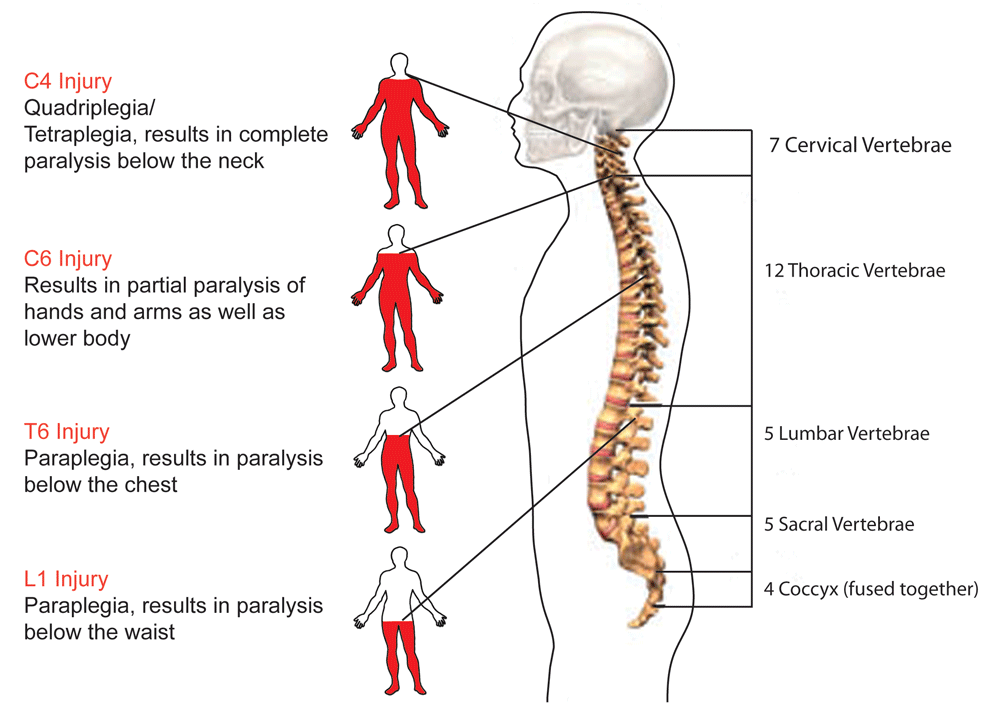Spinal injuries
All head injured and unconscious patients potentially have spinal injuries as well. The spine is divided into five areas:
- The cervical spine (neck), 7 vertebrae
- The thoracic spine (chest), 12 vertebrae
- The lumbar spine (back), 5 vertebrae
- Fused vertebrae of the sacrum
-
 A small vertebra called the coccyx
A small vertebra called the coccyx
Any injury to the spinal cord has serious ramifications for our ability to function normally. An injury or 'lesion', of the cord may cause quadriplegia (complete or partial paralysis of all four limbs); paraplegia (complete or partial paralysis of the lower limbs only); loss of: skin sensation, bowel, bladder and/or sexual function; as well as chronic painful conditions, depending on the location of the injury along the spinal cord.
The nearer the head the lesion occurs the more serious it is, affecting all levels of the body below it and potentially causing death if the nerves to the heart and lungs are involved. Even if the casualty is not affected to these degrees of severity, spinal injury may cause chronic back pain and restricted spinal flexibility. Spinal injuries can be caused by a variety of physical incidents. A common cause of spinal injuries is motorcycle accidents.
Riders and pillion passengers are thrown unprotected to the roadway and invariably land heavily in an awkward manner, putting stress on the spinal column.
Carefully assessing the history of the incident and the mechanism of injury will benefit the first aid provider before they apply active treatment. Road traffic accidents, diving accidents and sporting accidents provide the majority of spinal casualties. All head injured and unconscious patients should be treated as if they have a spinal injury as well.
Sign and symptoms
- History of the trauma, especially high speed accidents or contact sports
- Pulse may be fast or slow and is not generally a helpful indication of presence or severity of a spinal injury
- Unnatural posture
- May have pale, cool, clammy skin
- 'Tingling', unusual or absent feeling in limbs
- Absence of pain in limbs despite other injuries to these areas
- Inability to move arms and/or legs or weakness of movement
- Onset of shock
- Uncontrolled penile erection occasionally occurs
Care and treatment
- If airway is not open, use jaw thrust or manual opening of the jaw rather than extending the neck
- If unable to control airway - carefully remove the helmet while ensuring the minimum of neck movement
- Call Triple Zero (000) for an ambulance
- Extreme care in initial examination
- Always maintain the casualty's head in line with the shoulders and spine using manual support. Ensure the head is supported, not pulled or pushed in any direction. If trained to, apply cervical collar
- Position on spinal stretcher and use head- immobilisation device if trained to do so and equipment available
- Treat for shock
- Treat any other injuries
- Maintain body heat
- If movement required, use a 'log roll' using 2-or more people to assist you
Cervical collar
- A cervical collar helps immobilise the neck where cervical injury is suspected. First aiders trained in their use should apply a cervical collar, though it requires two people to apply correctly.
- The first rescuer applies manual support to the head and neck
- If the collar is adjustable or several sizes are available, measure the correct size according to the manufacturer's instructions
- The second rescuer slides the front of the collar along the casualty's chest and positions the chin piece
- The second rescuer gently wraps the ends of the collar snugly around the casualty's neck
- The second rescuer secures the collar with the Velcro tab
- Ensure collar is firm and comfortable, adjust if necessary
- Maintain support to the head and neck during all adjustments
Helmet removal
Helmets should only be removed if you intend to perform CPR or if the helmet is impeding airway management. If the helmet does not need to be removed then leave the helmet removal to the experts. The helmet could be helping prevent (further) spinal or head injuries.
It is important that you immobilise the casualty's head and spine by having one person place their hands on either side of the casualty's head (palms inwards) to keep it from moving. If you can, immobilise the neck and/or spine by placing rolled towels, articles of clothing, etc. on both sides of the neck and/or body, but don't interfere with the casualty's airway or breathing.